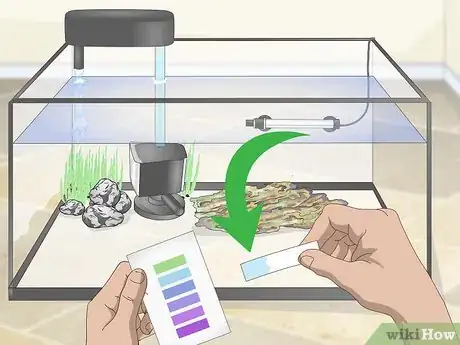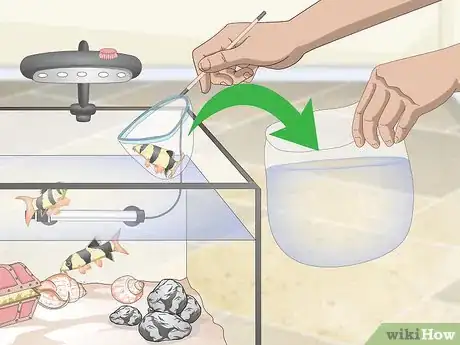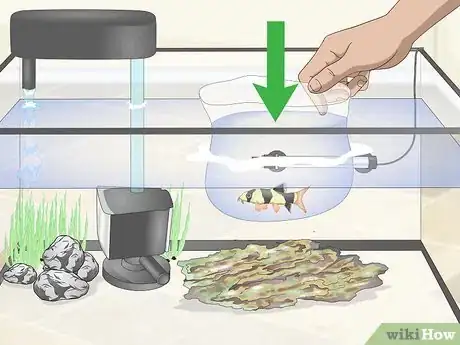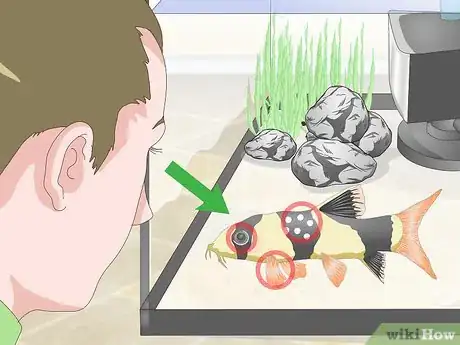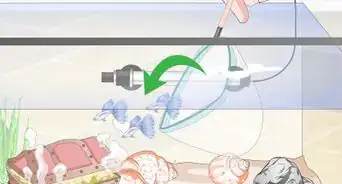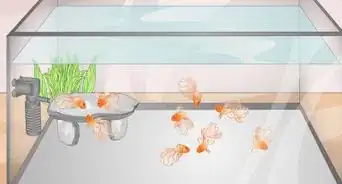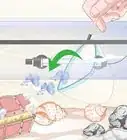This article was co-authored by Doug Ludemann. Doug Ludemann is the owner and operator of Fish Geeks, LLC, an aquarium services company based in Minneapolis, Minnesota. Doug has worked in the aquarium and fish-care industry for over 20 years, including having worked as a professional aquarist for the Minnesota Zoo and Shedd Aquarium in Chicago. He received his Bachelor of Science in Ecology, Evolution, and Behavior from the University of Minnesota.
There are 10 references cited in this article, which can be found at the bottom of the page.
wikiHow marks an article as reader-approved once it receives enough positive feedback. In this case, 95% of readers who voted found the article helpful, earning it our reader-approved status.
This article has been viewed 136,355 times.
You may need to quarantine freshwater fish before introducing new tank mates, when getting fish ready to breed, or to isolate sick fish. Quarantine tanks are smaller aquariums that separate some fish from your general fish population.[1] You can quarantine freshwater fish by setting up their separate tank, transporting your fish to their new tank, and recognizing when to separate freshwater fish into different tanks.
Steps
Setting Up The Quarantine Tank
-
1Equip your tank. Purchase a quarantine tank that is at least 10-20 gallons. Buy additional supplies including a filter to keep the water clean, a heater, a power head for surface agitation, and a fish net so you don’t infect fish in your main aquarium. These supplies can ensure the health and vitality of your quarantined fish until you reintroduce them to their primary tank.[2]
- Get an aquarium test kit for pH, ammonia, nitrate and nitrate if you don’t already have one to ensure that the tank water quality is high.
- The larger the fish, the more space you’ll need to house the quarantined fish.
-
2Fill the tank with water. Clean the quarantine tank thoroughly with hot water before adding water. Place it in a spot that is dark to keep your fish calmer.[3] Then use water from your main tank to fill the quarantine tank. This can ensure that your fish quickly acclimate to their new aquarium.[4]
- Avoid using soap when cleaning the tank because the chemicals can be toxic to fish.
- Add new water to the main tank by adding distilled water that you’ve treated so that it has similar properties.
Advertisement -
3Add the extras to the tank. Consider your quarantine tank to be an extension of your main tank. Place the filter, heater, and power head into the tank. Placing a few decorations and hiding spots can also help your fish feel more comfortable in their new surroundings.[5]EXPERT TIPDoug Ludemann is the owner and operator of Fish Geeks, LLC, an aquarium services company based in Minneapolis, Minnesota. Doug has worked in the aquarium and fish-care industry for over 20 years, including having worked as a professional aquarist for the Minnesota Zoo and Shedd Aquarium in Chicago. He received his Bachelor of Science in Ecology, Evolution, and Behavior from the University of Minnesota.Professional Aquarist

 Doug Ludemann
Doug Ludemann
Professional AquaristSet up a hospital tank that is a bare-bones aquarium. Use a bare bottom, simple filter, and simplistic decor you can take out and sterilize when needed. It's essential to keep the tank as clean as a hospital, which means no poop of food on the bottom, which can spread pathogens.
-
4Check the quarantine tank environment. Allow the filter to cycle a few times and start the power head to clean and aerate the quarantine tank water. Take the temperature of the water to ensure it’s the same as the main tank. Use your testing kit to ensure the pH is also similar or the same as the main tank. Making sure that the quarantine tank environment is the same or close to your main tank can maintain the vitality and health of your fish—and their offspring.[6]
-
5Remove the fish from the main tank. Fill a plastic bag with tank water so you can place the fish you want to transfer into it. Using your new tank net, scoop up the animal you want to quarantine. Then place the fish in the plastic bag and move it to the new tank. Removing your fish this way can minimize its stress and help maintain its vitality.
- If you have new fish, keep them in their plastic bag to prevent shock.[7]
-
6Acclimate your fish to the quarantine tank. Float the sealed plastic bag with your fish in the quarantine tank. Leave the bag in the water for 15 minutes so that the fish can gradually adjust to the water temperature. Cut the bag open the bag and allow the fish to swim free in the quarantine tank. Taking the time to acclimate your fish to the quarantine tank can minimize the risk of shocking the fish, which can harm its health.[8]
Treating and Returning Quarantined Fish
-
1Observe the fish. For 3-4 weeks, closely watch the health and vitality of your quarantined fish.[9] Look for the symptoms of potential problems to ensure prompt tank removal and treatment or when to remove male fish from the quarantine breeding tank.[10]
- White spots or velvety patches on the body
- Missing scales or incomplete fins
- Cloudy or bulging eyes
- Ulcers or other lesions
- Rapid breathing, gasping at the surface and shaking
- Erratic swimming
- Listlessness or sulking in a corner
- A bubble nest from male fish[11]
-
2Treat any illness. If any of your quarantined fish are ill or get sick, decide on the best course of treatment for it. This may include things such as improving water quality through cleaning or giving the fish medication.[12] Extend the quarantine at least two weeks from the time you start treatment to ensure that the fish can heal without additional problems arising. Once the fish appears healthy, leave it in the quarantine for an additional week.[13]EXPERT TIPDoug Ludemann is the owner and operator of Fish Geeks, LLC, an aquarium services company based in Minneapolis, Minnesota. Doug has worked in the aquarium and fish-care industry for over 20 years, including having worked as a professional aquarist for the Minnesota Zoo and Shedd Aquarium in Chicago. He received his Bachelor of Science in Ecology, Evolution, and Behavior from the University of Minnesota.Professional Aquarist

 Doug Ludemann
Doug Ludemann
Professional AquaristQuarantine your fish in a hospital-clean tank and watch for illness. If you see ich, bacteria, or other illnesses, do your best for treatment. Don't add your fish back into the main tank until it has been healthy for around 30 days straight.
-
3Move fish back to the main tank. Once your fish is healthy, remove it from the quarantine tank with the new net. Place the fish in a plastic bag with water from the main tank. Then put the sealed plastic bag in the main tank for 10-15 minutes before letting your fish swim free.[14] [[
- Avoid mixing quarantine water into your main tank, as it could still contain medications harmful to your other fish.
-
4Clean and store the quarantine tank. Disinfect your tank and equipment once the quarantine is over. Mix 200mg bleach with one liter of water in the tank. Use more for larger tanks. Scrub down the tank surfaces and equipment with the bleach mixture and rinse thoroughly with clean water when you’re done.[15] Allow the tank and equipment to air dry, which can kill any lingering pathogens. Then store the tank in a clean, dry spot in your home.
Community Q&A
-
QuestionDo I need a quarantine tank if I'm mixing two fish from the same pet store that were originally in different tanks?
 Terry SheltonCommunity AnswerIf they are the only fish you have, then no. If not, quarantine both in the same tank before introducing them to your other fish.
Terry SheltonCommunity AnswerIf they are the only fish you have, then no. If not, quarantine both in the same tank before introducing them to your other fish. -
QuestionCan I use a quarantine tank without a filter?
 Llp33Community AnswerFor a short period, yes, but make sure that you do regular water changes. If a fish is sick, it might stress it out to have a strong filter current.
Llp33Community AnswerFor a short period, yes, but make sure that you do regular water changes. If a fish is sick, it might stress it out to have a strong filter current. -
QuestionI did everything right starting up my new tank, but lost 5 out of 7 fish to ich. I've been treating them. When can I get new fish, and what do I have to do to my tank? I have now started a quarantine tank.
 LeahlovesGodTop AnswererPlace your remaining 2 fish in the quarantine tank. Clean out your original aquarium and have it cycle (with the pumps and/or bubblers running) for a week afterwards. Make sure that after you clean the tank you add special freshwater salt. This helps to prevent fish from getting ich. Acclimate your remaining 2 fish back into the aquarium once they seem better. The freshwater salt is good for the quarantine tank as well. Once the tank is cleaned, you may add new fish.
LeahlovesGodTop AnswererPlace your remaining 2 fish in the quarantine tank. Clean out your original aquarium and have it cycle (with the pumps and/or bubblers running) for a week afterwards. Make sure that after you clean the tank you add special freshwater salt. This helps to prevent fish from getting ich. Acclimate your remaining 2 fish back into the aquarium once they seem better. The freshwater salt is good for the quarantine tank as well. Once the tank is cleaned, you may add new fish.
Warnings
- Immediately remove any dead fish from the tank.⧼thumbs_response⧽
Things You'll Need
- 10 gallon (37.9 L) fishtank with hood and light (larger if necessary)
- Filter
- Heater
- Simple hiding places such as clean PVC pipe
- Power head for surface agitation and aeration
- Fish net
- Testing kit for pH, ammonia, nitrate and nitrite
References
- ↑ http://www.fishlore.com/QuarantineTankSetup.htm
- ↑ https://www.fishlore.com/QuarantineTankSetup.htm
- ↑ http://www.tfhmagazine.com/aquarium-basics/columns/quarantine.htm
- ↑ https://www.fishlore.com/QuarantineTankSetup.htm
- ↑ http://www.drsfostersmith.com/pic/article.cfm?articleid=1119#answer_2
- ↑ http://www.drsfostersmith.com/pic/article.cfm?articleid=1119#answer_2
- ↑ http://www.aspca.org/pet-care/small-pet-care/fish-care
- ↑ http://www.aspca.org/pet-care/small-pet-care/fish-care
- ↑ http://www.tfhmagazine.com/aquarium-basics/columns/quarantine.htm
- ↑ http://www.tfhmagazine.com/aquarium-basics/fish-selection--stocking-guide.htm
- ↑ http://www.aquaticcommunity.com/bettafish/breeding.php
- ↑ https://www.fishlore.com/Disease.htm
- ↑ https://www.fishlore.com/QuarantineTankSetup.htm
- ↑ http://www.aspca.org/pet-care/small-pet-care/fish-care
- ↑ http://www.tfhmagazine.com/aquarium-basics/columns/quarantine.htm
About This Article
To quarantine freshwater fish, first set up a quarantine tank that's at least 10 gallons by filling the tank with treated water and installing a filter, heater, and power head. You should also add a few decorations and hiding spots to help your quarantined fish feel more comfortable. Then, test and adjust the water in the tank so it matches the conditions of the water in your main fish tank. Finally, transfer the fish you need to quarantine into sealed plastic bags, and float them in the new tank for 15 minutes to acclimate them before releasing them. For tips on how to return quarantined fish to their old tank, scroll down!



